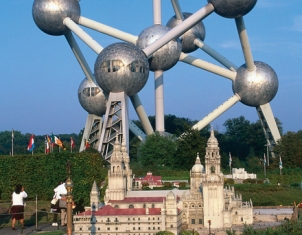Brussels more than just the capital of Eurocracy
 Brussels - Its most famous landmark is the Manneken Pis - a bronze fountain of a boy urinating - and it is home to tens of thousands of Eurocrats who are in some way tied to the European Union. Brussels might be a quirky city, but a nice one that is worth a visit.
Brussels - Its most famous landmark is the Manneken Pis - a bronze fountain of a boy urinating - and it is home to tens of thousands of Eurocrats who are in some way tied to the European Union. Brussels might be a quirky city, but a nice one that is worth a visit.
As the seat of European institutions such as the EU, Brussels functions as the de facto capital of the continent. While it would be an exaggeration to describe it as a metropolis, Brussels has a lot to offer. There must be a reason for the large number of people who work in Paris, but live in Brussels.
The city has a population of 150,000. It actually lies in Flemish-speaking Flanders (Flemish is a Dutch dialect). But Brussels itself is bilingual, although French is more prominent in the city centre. And even though there are regular spats between the Belgium regions of Flanders and French-speaking Wallonia, Brussels gets by with its wealth of languages. The street signs are in two languages, many residents of Brussels can speak Flemish and French, and children from the different regions learn each other's languages in school.
Architecturally, Brussels has a lot to offer. Among other things, art-nouveau has its roots here with Brussels architect Victor Horta a pioneer. Numerous small city houses are true art-nouveau pearls. The Grand-Place with its Gothic town hall is on UNESCO's World Heritage List of buildings considered as having outstanding universal value.
The central plaza is often thick with tourists who come to taste Belgian waffles and fritters and drink sweet Belgian beer. They also are drawn by such attractions as the palace of King Albert II, the European Parliament and the Atomium, a symbol of the World Expo held in Brussels in 1958. The city was largely spared in World War II. Nevertheless, many old buildings have been destroyed and replaced by modern, unappealing projects.
Even today entire streets fall victim to the wrecking ball. This is particularly true in the European quarter where European institutes have been located since 1958. Initially, this was the European Commission, which evolved into the European Union. Now the area of the city also includes the ministry and the parliament. Eurocrats, diplomats, journalists, EU representatives and thousands of lobbyists live and work there.
Despite the presence of an international Who's Who, culture lovers can have a long wait for first class opera, theatre and ballet performances. But those who don't have to see the creme de la creme can find rich cultural offerings at the La Monnaie Opera and in the city's galleries and theatres. The fashion and jazz scenes are also vibrant.
The city is also proud of its variety of comics painted on the walls of apartment buildings. There's a museum devoted to famous comics artists such as Herge, a Brussels-born artist who created the comic strip Tintin. Although he spent most of his life in Paris, singer Jacques Brel is another famous son of Brussels. (dpa)